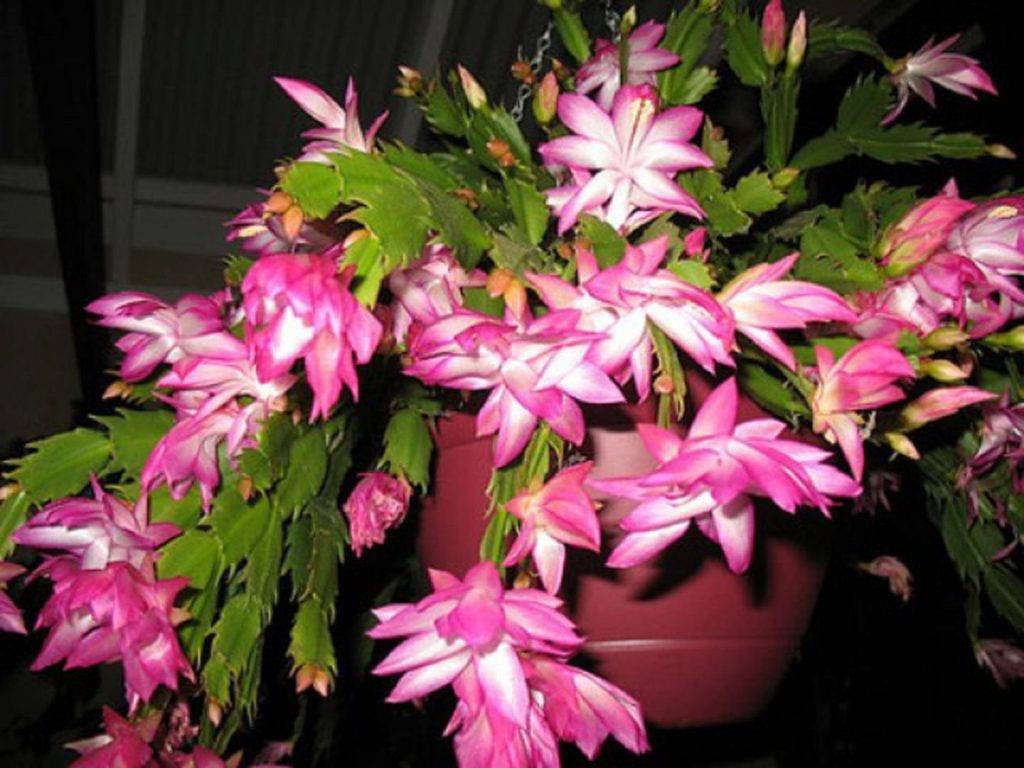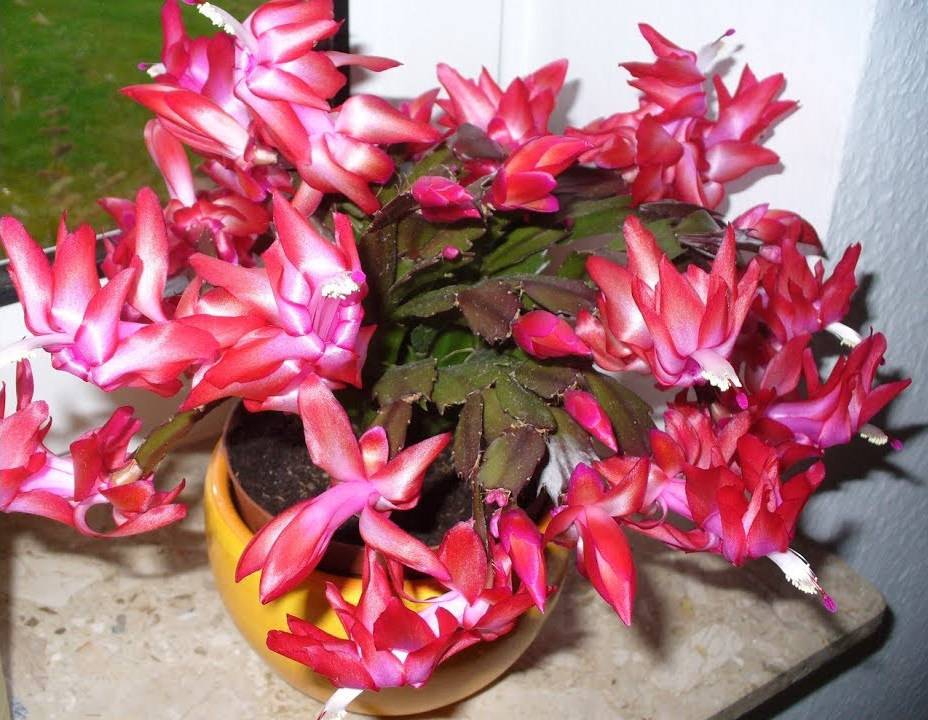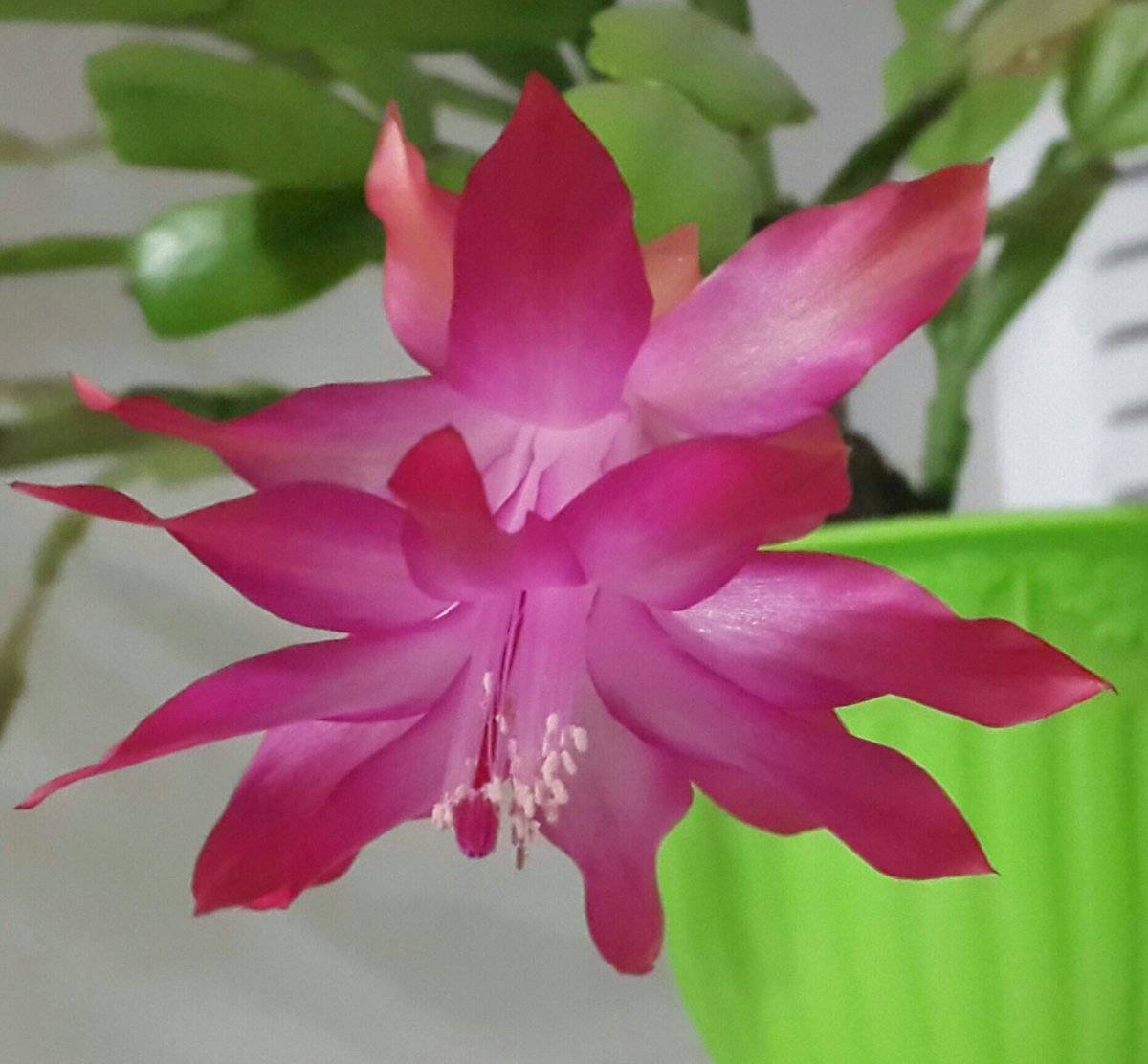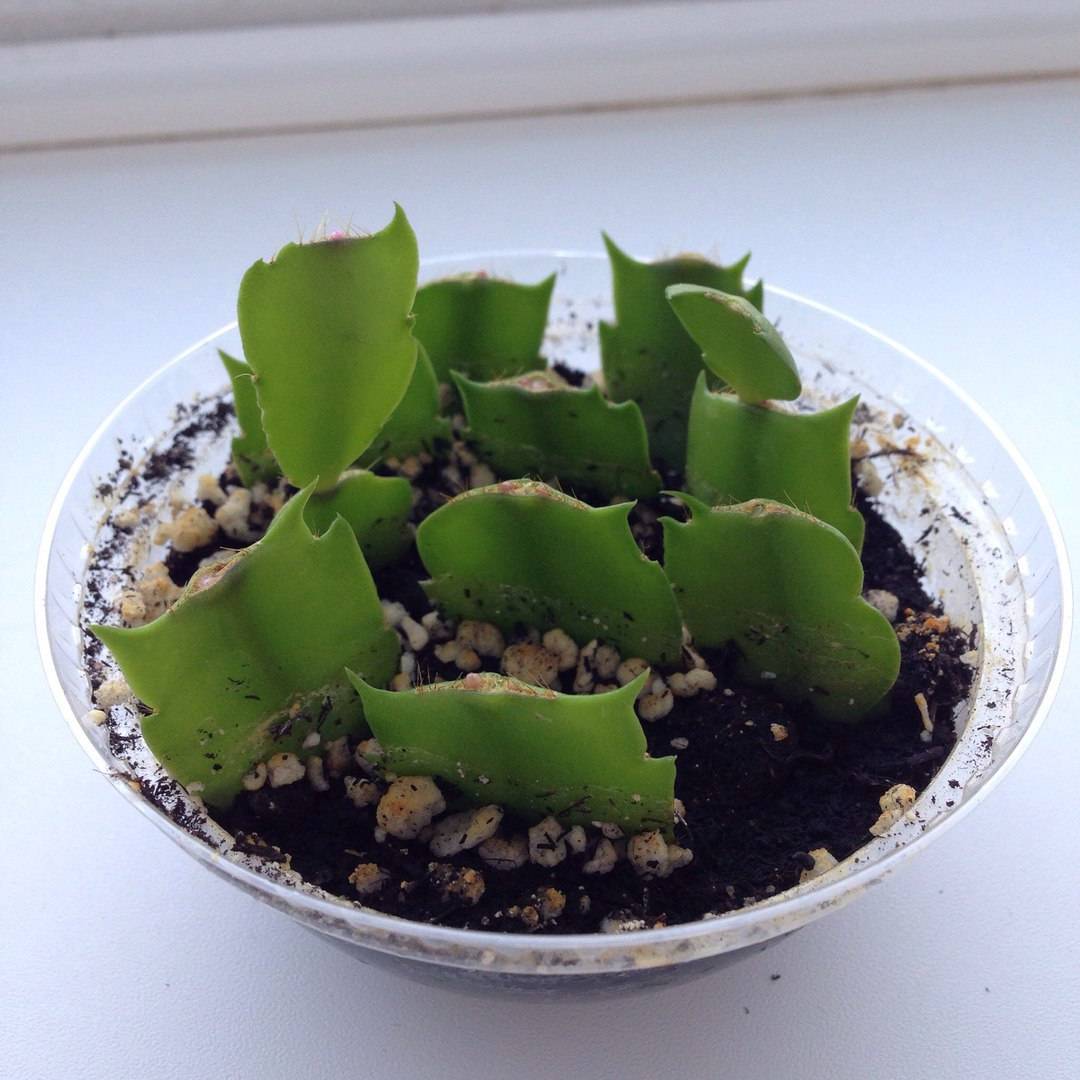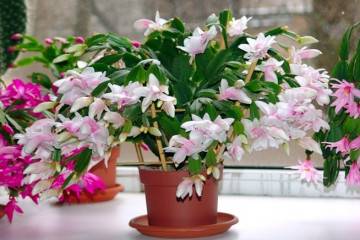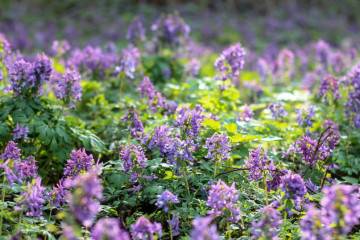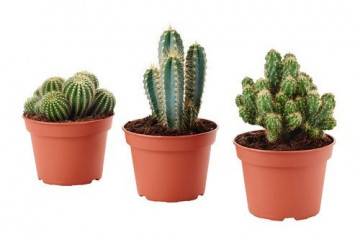Decembrist flower - how to plant and care
Content:
The Decembrist flower is a common houseplant, a special feature of which is flowering in the cold season. The flower itself is relatively small and has flat green stems that are divided into segments. Caring for a Decembrist flower at home is simple. Moreover, he lives for a long time and blooms profusely.
Description of the flower
Decembrist, also called zygocactus, Schlumberger, a representative of the Epiphytic cactus family. In its natural environment, this plant lives in tropical forests, where it grows on tree trunks.
Popular varieties
Decembrist is a flower that has many different varieties, the main differences between them are in flowering time and the shape of the bud itself. The most popular ones are presented below.
Distinctive features of the truncated variety are denser stems, the length of the segments of which reaches 5 cm and the width of 2.7 cm.The plant blooms mainly in December, as if, in spite of cold days, illuminating the room with bright crimson flowers, the size of which can reach 8 cm.
Buckley is one of the first species that breeders managed to breed. The flower is less peaceful, since it has sharp teeth at the edges. Despite all the belligerence, the Decembrist Buckley blooms incredibly beautifully. Large tubular flowers are most often found in purple, yellow or pink. The plant reaches a height of 50 cm.
In the very name of Russelian there is a clue to the description of the flower. The stems of the plant reach a length of 80 cm and hang down like vines. The flowers are large and multi-tiered. Most often found in deep red.
How to follow a Decembrist at home
In nature, the Decembrist cactus grows on other plants, preferring the crevices of tropical trees. Accordingly, to grow zygocactus at home, you need a loose soil saturated with microelements.
It's easy to prepare the optimal soil for the Decembrist at home. You will need coarse sand and leafy soil (compost) in a 1: 1 ratio. Peat and wood char are perfect for saturating the soil. Gravel, expanded clay, broken brick can be used as a drainage layer. The layer height should be 1/3 of the pot height.
Temperature regime
Decembrist loves care at a temperature of 1 ° C to 35 ° C. Of course, you should not expose a flower to such tests. The optimum temperature that should be maintained indoors is between 20 ° C and 26 ° C.
During the flowering period, the Decembrist loves warmer places, where the air temperature is warmed up from 18 ° C to 20 ° C.
Lighting
The Decembrist does not like direct sunlight. In the summer, it is better to choose shaded places for a plant, since an excess of ultraviolet radiation can be detrimental to it.
Watering
When watering Schlumberger, moderation is key. The plant does not tolerate stagnant water. Over-watering will cause the roots to rot. During the flowering period, it is necessary to maintain moderate soil moisture; complete drying is unacceptable.
After flowering, the plant needs less watering. You can only use settled water at room temperature. Proper care is the key to a beautiful and lush bloom.
Spraying
Zygocactus loves soft warm showers, especially in summer. In the cold season, it is better not to spray the Decembrist, as you can damage the buds.
Humidity
Schlumberger needs care like a tropical plant, so the air humidity must be kept in the region of 50-60%. In a hot period, water can be poured into the flower pan so that it does not touch the bottom of the pot and does not soak into the ground, but simply evaporates, creating comfortable conditions for the plant.
Top dressing
You can feed the plant only during the dormant period - in summer and spring. As a fertilizer, store-bought supplements for the Cactus family are suitable.
Top dressing can be introduced no earlier than a month after transplantation. The use of concentrated fertilizers, which are based on nitrogen, is prohibited, since an excess of the flower will become lethargic and can rot.
Features of care during dormancy and flowering
Many growers do not know how to care for a Decembrist from February to September, when the plant is in the active growth stage. During this period, the flower takes a warm shower, moderate sunbathing and loves fresh air with pleasure.
From October, the plant begins a period of preparation for flowering. It depends on the literacy of caring for him at this time whether the Schlumberger will please the gardener with his flowers this year or not.
During this period, it is worth watering the plant only when the segments look shriveled from lack of moisture. Sunbathing is best achieved through shading. But fresh air and coolness, on the contrary, during this period have a beneficial effect on the laying of buds.
The Decembrist, whose care during the active phase must be carried out especially carefully, prepares for flowering in the period November-January. If the plant has been on the balcony before this time, it must be brought into the room. During this period, flower treatment, transplantation, as well as sudden temperature changes are unacceptable.
When and how the Decembrist blooms
A distinctive feature of the Decembrist is flowering at a time unusual for other indoor plants - these are the cold months from November to January. Depending on the variety, the Schlumberger delights gardeners with a variety of colors.
Golden Cream is the pride of breeders, as it is the only member of the family that blooms with delicate yellow flowers. Sunny flowers appear mainly in December. An unusual Decembrist, who was properly cared for, can delight with flowers on New Year's Eve.
The pride of breeders is the white Decembrist, which is characterized by a longer flowering period. The white Schlumberger has several subspecies:
- White Christmas. A distinctive feature of the plant is its white flowers with delicate pink stamens. The bush grows up to 50 cm in height;
- Bridgeport — a small bush, which at the same time has rather large flowers with oval-shaped leaves. Coral-colored stamens complete the composition;
- Madame Butterfly. So pathetic can only be called a special variety, which is distinguished by large inflorescences with a delicate purple frame around the edges of the petals. The flowers are multilevel. They, unlike their brothers from the family, begin to open earlier - from October to November;
- Angel dance. This type of Decembrist is considered an albino, it is pure white in color without any additives;
- The white bell is a small bush that produces two-tiered flowers during the active season. Has a longer flowering period.
How to trim properly
Pruning the Decembrist helps to increase the splendor and number of flowers in the next season. Pruning should be carried out strictly at the junction of two segments in the post-flowering period - from February to August.
How a flower multiplies
The Decembrist at home reproduces vegetatively, that is, by restoring the lost parts. To do this, you can use parts on which the processes of aerial roots have already appeared.
The mixture for the growth of a new Decembrist must be sterile and consist of deciduous humus and charcoal. Young shoots must be rooted in small transparent, plastic cups, deepening the cutting 1/2 into the ground.
Features and growth conditions of Decembrist cuttings:
- rooting lasts 3 to 5 weeks;
- there should be enough light, but shading is necessary;
- temperature regime from 21 ° С to 25°FROM;
- air humidity from 60-70%;
- watering only after slightly drying the earth.
In a transparent cup, the appearance and strengthening of the roots will be noticeable. This is a signal that the flower is ready for adulthood and can be planted in a larger pot.
Transfer
A Decembrist may need a transplant in several cases:
- after buying a flower, since, mainly for sale, shoots are planted in a peat composition, which is not suitable for the constant growth of a flower. After purchase, the plant must be given time to rest for at least 1.5-2 weeks. During this period, it is also possible to determine whether the flower suffers from any disease;
- the roots of the plant were visible through the holes in the bottom of the pot. This means that the container has become small for the flower, and it is necessary to prepare a more spacious flowerpot.
The best time for transplanting is spring, since during this period ideal conditions are naturally created for the Decembrist: cool, fresh air with moderate humidity, short daylight hours. The sun during this period is not yet so aggressive. In addition, during the period of active leaf growth, the Decembrists especially easily tolerate transplantation.
In the case of adult bushes, it is better to avoid transplanting altogether, since the root system has already become so dense and overgrown that it will not be difficult to damage it. You can periodically change the topsoil.
Step-by-step instructions for transplanting a Decembrist:
- Carefully remove the plant from the old pot, after separating the ground from the sides with a flat spatula.
- As much as possible, clean the roots of the old soil as thoroughly as possible. A soft brush or an old toothbrush will do this.
- Transfer to a new pot with prepared soil and a depression in the center.
- Fill with new soil from above, completely covering the roots with earth.
- Drizzle liberally until water emerges from the holes in the bottom of the pot.
Possible growing problems and diseases
If you do not follow the basic rules, the plant may start to hurt.
- segments of the flower began to turn red. Reason: the Decembrist stood in the cold. Solution: move the flower to a warmer place;
- the segments began to wrinkle and wither. Reason: underfilling or, on the contrary, overflowing. Solution: in case of a lack of moisture, the plant needs to be watered well. If the reason for the deterioration of the Decembrist's condition was excessive watering, it is necessary to examine the root system. Dead, rotten roots need to be cut off and the flower transplanted into new soil. It is better to plant a flower in a new pot;
- all the buds have fallen, the Schlumberger does not bloom. Reason: stress, the pot was moved from place to place during the flowering period, which is strictly prohibited. The plant was standing in a draft or in direct sunlight. Over-watering or, on the contrary, under-watering took place. Unfortunately, in this case, one can only draw conclusions as to why this happened and prevent such mistakes in the next year.
Signs and superstitions: truth or fiction
The Decembrist perfectly feels the atmosphere of the house. If the plant grows beautifully, blooms, it means that the house is filled with love and care.
The flowering of the Decembrist earlier than usual speaks of unexpected good news, an improvement in the financial situation in the family, an increase in the career ladder.
In the old days, the Decembrist was afraid to keep at home, as they considered him a harbinger of death. If the Decembrist began to wither and died, then the family needs to prepare for mourning. In modern society, such terrible properties are not attributed to the Decembrist. A flower can die for a variety of reasons, regardless of the events taking place in the house.
In any case, a beautiful, gentle, unpretentious Decembrist will be a wonderful decoration for any interior. And bright flowers in a cold winter will undoubtedly bring comfort and warmth to the house.


